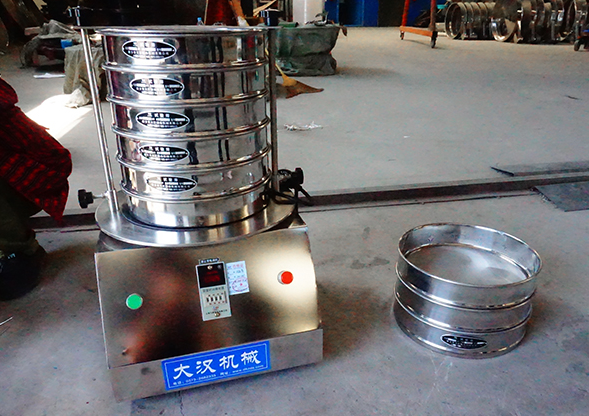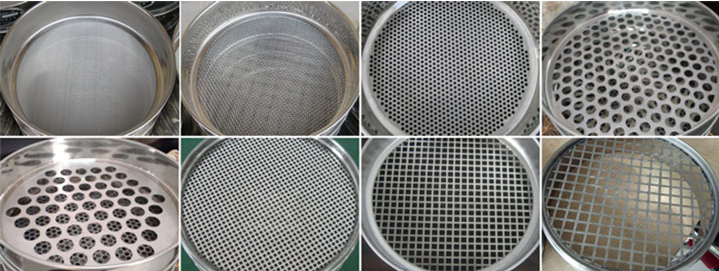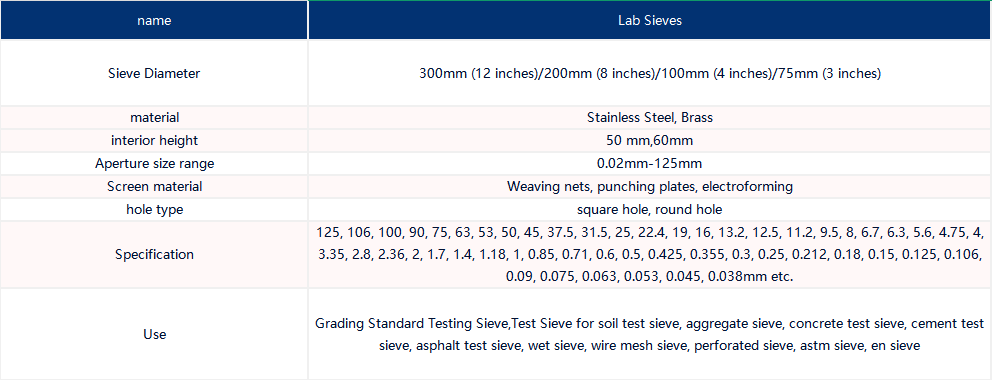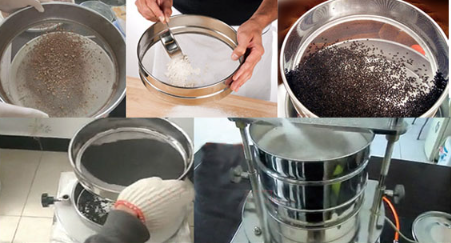![[field:title/]](/uploads/allimg/250111/2-2501111J124I2-lp.png)
Suitable for particle size analysis and screening of various granular or powdery materials, accurate separation and determination of the particle size distribution of materials.
Standard sieve size: 200x50mm
Sieve hole size: 0.025-4mm
Standard mesh: 5-600
Selling points:
1. Precisely separate 2-7 particle segments of a granular material at the same time
2. Low noise and light weight
3. With timed automatic shutdown function to ensure test repeatability

Lab Sieve is an experimental instrument used for screening and particle size analysis of granular materials. It usually consists of a series of sieves with different apertures, which are stacked in order of aperture size. Through sieves with different apertures, particles of different sizes can be separated to obtain information on particle size distribution. This is of great significance for research and production in the fields of materials science, chemistry, food, and medicine.
2. Quality control: In laboratories in the chemical, pharmaceutical, food and other industries, it is used to perform quality inspections on raw materials and products. In the pharmaceutical process, drug powders are screened to ensure that their particle size meets the requirements of the preparation and to ensure the quality and efficacy of the drug. In the food industry, it is used to detect the particle size of food raw materials (such as flour, powdered sugar, etc.) to ensure the taste and quality of the product.
3. Sample preparation: Provide samples with uniform particle size for subsequent experiments. In soil science research, Lab sieves are used to sieve soil samples to remove larger particles and impurities to obtain fine particle samples suitable for analyzing soil microorganisms, nutrient content, etc.

The sample to be tested is spread evenly on the sieve, and the particles are moved on the sieve by means of vibration or sieving machine. Particles of different particle sizes will pass through sieves of different apertures and eventually be sieved into particles of different grades.
The structure of lab sieve
Sieve frame: usually made of stainless steel, durable and not easy to deform.
Sieve mesh: woven from metal wires of different mesh sizes, the larger the mesh size, the smaller the aperture.
Chassis and cover: used to fix the screen to prevent material splashing during screening.

1. Classification by screen shape
Circular Lab sieve: The sieve frame and screen are circular. The structure of this shape of Lab sieve is relatively symmetrical. The force of the material is uniform during the screening process, which is conducive to fine screening. When analyzing samples with high particle size requirements, circular Lab sieves can provide more accurate results.
Square Lab sieve: The sieve frame and screen are square, and its advantage is that the screening area is relatively large and can handle more materials. It has advantages when performing preliminary screening of larger batches of samples or screening materials with a wide particle size distribution. For example, in the preliminary screening of soil samples, square Lab sieves can more efficiently remove large particle impurities.

2. Classification by mesh material
Lab sieves of different materials: such as stainless steel wire woven mesh Lab sieve, perforated plate Lab sieve, plastic mesh Lab sieve, etc. Stainless steel wire woven mesh Lab sieve is suitable for fine screening of most materials; perforated plate Lab sieve is used for heavier and larger particles; plastic mesh Lab sieve has unique advantages in screening some materials with special chemical properties.

1. Accurate particle size analysis: It can accurately determine the content of particles of different particle sizes in the sample. Through screening, the particle size distribution curve of the sample is obtained, which intuitively reflects the particle size characteristics of the sample.
2. Efficient classification: It can quickly separate particles of different particle sizes to improve work efficiency. The purity of each level of particles after separation is high, which is conducive to subsequent experiments.
3. Strong customizability: Lab sieves are available in a variety of specifications to meet different experimental needs. Screens with different apertures can be customized according to experimental needs.
4. Simple operation: No special training is required. Some lab sieves have automation functions to improve work efficiency.



Lab Sieve s are widely used in various Lab environments, including but not limited to: soil analysis laboratories, material science laboratories, chemical laboratories, mineral laboratories, and food science laboratories. In these laboratories, Lab sieves are used for screening, grading and particle analysis of granular materials to provide data support for experiments and research. Lab sieves are common equipment in laboratories, used to screen and grade granular materials to meet the needs of experiments and research.

Juice 20cm test sieve is a screening tool specially used in juice production and related research fields. It usually has specific size specifications, the diameter or side length of...
20cm test sieve for garden soil
20cm test sieve for garden soil is used in horticultural soil management to analyze particle size distribution to determine soil type, texture, and fertility and to screen out impur...
Chinese herbal medicine vibrating screen
Chinese herbal medicine vibrating screen is a piece of equipment specially used for screening Chinese medicinal materials. ......
Laboratory test sieve is commonly used sieving tools in laboratories and is used for particle size analysis and classification of granular materials. Laboratory test sieve usually c...
Are you interested?
![]()
Then we look forward to hearing from you
Contact Us
Industrials
Yanjin county forest park gate to the west 1000 meters north road sitemap
